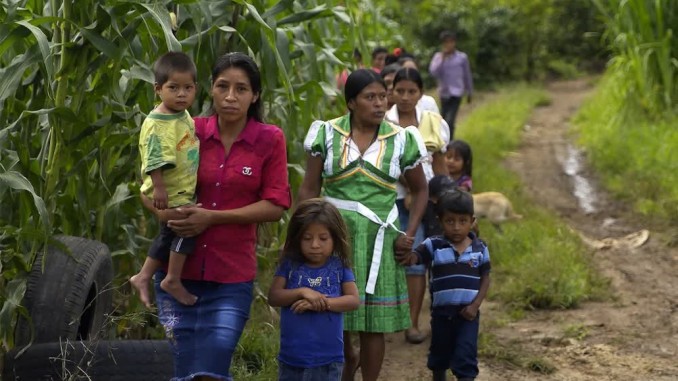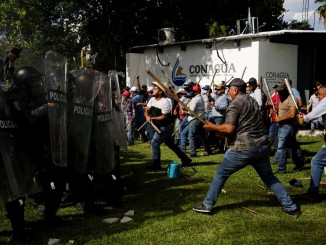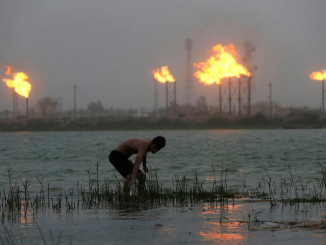
In Guatemala, the devastating effects of colonialism and U.S. imperialism are now converging with climate change to create an unprecedented hunger crisis. Child malnutrition rates in the country are around 70% – among the highest in the world. The rise in poverty and hunger in Guatemala has caused increased migration to the United States in recent years. About 3 million Guatemalans live in the U.S. – the vast majority having migrated due to the inability to find jobs and feed their families. The Covid pandemic has only worsened this crisis, driving more Guatemalan refugees to the United States. The immediate causes of the food crisis are failed harvests due to global heating and hurricanes. But the economic crisis has deeper roots in a long history of colonialism and U.S. imperialism.
Colonialism
Before the Spanish conquests of the 16th century, Guatemala was home to both hunter-gatherers and (from 2000 BCE) a developed agricultural civilization now known as the Maya, which included a network of connected cities. In 1524, the Spanish conquistador Pedro de Alvarado landed in present-day Guatemala. He and Hernán Cortés had just concluded the bloody taking of Mexico from the Aztecs, and Alvarado launched a similar campaign against the Mayans. It took over a century of genocide and pillage for the Spanish to conquer the entire region.
The Spanish invaders transformed Guatemala into an important port for shipping goods between Latin (that is, Spanish- and Portuguese-conquered) America and Asia. The conquest introduced a population of European descent as well as a minority of people from African descent who were kidnapped into slavery. The Spanish also introduced the Catholic Church, which converted much of the population. About half of Guatemala’s 16.8 million people today are Catholic, and about 44% identify as indigenous.
U.S. Imperialism
In the 19th century, Guatemala achieved what is usually called “independence.” This does not mean that the farmers and workers became independent of their rich exploiters. Rather it means that Guatemalan and Mexican army generals overthrew the direct rule of the Spanish monarchy, and assumed direct control of the territory. In the latter-half of the 19th century, various military generals and capitalist politicians fought over who gets to rule Guatemala and exploit its people. The conservative elites relied primarily on agriculture (that is, exploiting farmers), whereas the capitalists wanted to modernize the economy, introduce more trade with neighboring countries, and expand the cities and urban working class. By the end of the century, the capitalist modernizers prevailed with the help of the U.S. ruling class. The so-called “independence” of the Latin American countries was simply a process of transition from one form of domination to another: from colonialism to capitalism in its developed form known as imperialism. Instead of the Latin American countries being official colonies of a European power, the local ruling classes acted as privileged facilitators for the bigger capitalists of the United States, who extracted profits from Latin American labor and natural resources. Mainstream economists call this “globalization.” The imperialist domination of Guatemalan workers by foreign (mostly U.S.) corporations continues to this day.
The U.S. corporations that profited from Guatemalan land and labor worked hand in hand with the U.S. State Department in order to consolidate their rule. One of the decisive concessions was made to the U.S. company United Fruit, which came to dominate the region. By the 1920s, United Fruit controlled the governments of Central America so tightly that it was known as El Pulpo (the octopus). United Fruit worked with Guatemala’s capitalist government to murder farmers and workers who organized for more humane working conditions and living wages. The company came to own much of the country’s farmland, kicking off indigenous farmers in order to expand their banana plantations. United Fruit bombarded the U.S. public with advertising for bananas, making the fruit very cheap and popular in the U.S. at the expense of the immense misery inflicted on Central American laborers.
The Great Depression of the 1930s dealt a severe blow to the economy of Guatemala, causing mass unemployment and poverty among workers and farmers. The rich landowners needed an authoritarian government to put down unrest among the poor, so they supported ex-military general Jorge Ubico, who became president in 1931. Ubico expanded the police and government surveillance, gave landowners and corporations free reign to murder disobedient workers, and forced indigenous people into slavery, terrorizing them with torture and rape. He gave even more concessions to United Fruit, helping them expand and consolidate their control over farmland and railroads in Guatemala.
Much of the exploitation and terrorizing of Guatemalans was managed by the U.S. government on behalf of the capitalists who profited from it. The administrations of Presidents Hoover and F.D. Roosevelt were instrumental in ensuring total control of Central America by U.S. corporations. They supported dictators in Nicaragua, Honduras, El Salvador, and Guatemala as long as these maintained order, which meant bloodily suppressing workers’ resistance, as well as putting down rebellions of indigenous farmers who were kicked off their land. FDR’s New Deal took advantage of the relative weakness of major U.S. banks during the Great Depression of the 1930s to bring the economic management of Central America under government control. Washington officials then directly supervised Central American governments in exchange for government-backed loans. This consolidated the exploitative integration of these economies almost exclusively into that of the United States. Of Guatemala’s $50 million in exports in the year 1948, $45 million went to the U.S., $42 million of which was in coffee and bananas. In the other direction, 82% of Guatemala’s imports were from the United States. However, as historian Walter Lafeber writes, “the Central American exports profited only a small group in each country, and only that group had the money to buy many of the imported goods.”
In 1944, the extreme repression of the Ubico regime became so intolerable that the workers of the capital Guatemala City went on a general strike in June. The movement forced Ubico to resign, but his hand-picked successor continued the brutal crackdown on the protests. He too was forced out of power in October by a military coup, sometimes known as the “October Revolution.” The military junta called for elections, in which the liberal university professor Juan José Arévalo was elected as president in 1945. Arévalo relaxed state repression against workers and farmers somewhat, allowing the labor movement to expand. His successor Jacobo Árbenz (elected in 1951) continued this trend, and even initiated a land reform beginning in 1952, which was meant to hand over Guatemala’s unused private land to about 500,000 small farmers – including land owned by the mighty United Fruit Company. Árbenz formally legalized the Communist Party, which came to dominate the labor movement and the largest unions, and whose members successfully ran for various government positions, exercising influence on the administration.
These developments angered the U.S. ruling class, and especially the capitalists of United Fruit. The threat perceived by the U.S. capitalists was not an immediate but a potential one, and was a product of the atmosphere of Cold War tension between the United States and the Soviet Union. The Chinese Revolution of 1949 (led by the Chinese Communist Party) contributed to this fear among the U.S. elites of any influence that Communist Parties might have in any country. These parties were allied with the Soviet Union, and were influenced (and often even directed) by the Soviet regime. Since the rise of Stalin to power, the Soviet Union had nothing to do with socialism or communism in the real sense of working-class power, but it competed with the U.S. ruling class for world domination – and did so by mobilizing oppressed populations against pro-U.S. regimes. For that reason, any Communist Party in the world was deemed a threat to U.S. “national interests” (meaning the interests of the richest U.S. capitalists). A CIA report from March 1952 stated that “The Communist Party of Guatemala has no more than 500 members,” yet exercises in Guatemala “a political influence far out of proportion to their small numerical strength.” It further identified Árbenz as a threat:
Árbenz, to attain the Presidency, made with the Communists commitments of mutual support which importantly affect the present situation. He did not, however, surrender himself completely to Communist control. […]
The political situation in Guatemala adversely affects U.S. interests and constitutes a potential threat to U.S. security. […] If the [United Fruit] Company should submit to Guatemalan demands the political position of the Árbenz Administration would be greatly strengthened. It is probable that in this case the Government and the unions, under Communist influence and supported by national sentiment, would exert increasing pressure on other U.S. interests, notably the Railway.
Árbenz was no communist, and the CIA recognized this. An October 1952 report stated:
Rather than setting up a Communist state, Árbenz desires to establish a “modern democracy” which would improve the lot of its people through paternalistic social reforms. Árbenz’s personal idol is FDR and his reforms are patterned after New Deal reforms and adjusted to the backward economy and social structure of Guatemala.
Nevertheless, the CIA and State Department saw Árbenz’s land reform as a slippery slope that could extend “communist influence” among farmers and workers, expanding labor unions, and weakening the power of United Fruit and other U.S. corporations in the region. Presidents Truman and Eisenhower authorized covert operations to remove Árbenz from power, and the CIA began training militias to prepare for a coup. The invasion of the militias in 1954 coincided with U.S. bombings of the capital and a CIA propaganda campaign – smearing Árbenz as a communist puppet of Moscow, and exaggerating the strength of the poorly trained CIA-trained militias (which numbered only about 400 men). Árbenz was unable to mobilize the demoralized Guatemalan army against the invasion, and was forced to resign shortly after the coup.
The leader of the CIA-trained militias, Carlos Castillo Armas, became president in a so-called “election” in which he was the only candidate, as all parties were banned by his National Committee for Defense against Communism. Armas reversed the land decrees, returning land to the big landowners and corporations, and violently persecuted labor and peasant organizations, imprisoning and murdering thousands of people. His successor, Ydígoras Fuentes, continued these repressive policies. He also supported the training of anti-Castro militias at the request of the Eisenhower Administration, in preparation for the attempt to topple Fidel Castro’s government in 1961 (the Bay of Pigs Invasion).
In November 1960, a failed military coup against the Ydigoras government launched the long Guatemalan Civil War. The defeated insurgents regrouped in the next year and attacked United Fruit offices in 1962, sparking widespread protests and strikes across Guatemala. A succession of pro-U.S. presidents cracked down violently on the uprisings, and the Green Berets and CIA trained counterinsurgency forces in the Guatemalan military, as well as far-right death squads that terrorized workers and farmers. The death squads tortured and murdered anyone suspected of being affiliated with farmer or labor organizations. The military used a “scorched earth” campaign in the 1980s, destroying hundreds of Mayan villages. The country was subjected to U.S.-sponsored terror for 36 years, with an estimated death toll of 200,000. Over a million people became refugees.
The Civil War ended in 1996, but the death squads continue to operate in affiliation with the state and organized crime (mainly drug cartels). In Guatemala, as in Mexico and other Latin American countries, the forces of the state and of organized crime are so enmeshed that there is hardly a line between them. In 2012, the U.S. stationed Marines and private military contractors in Guatemala as part of its “War on Drugs.” This war is a pretext for mass incarceration in the U.S. (with Black populations disproportionately imprisoned) as well as for exercising tighter control over Latin America. As historian Greg Grandin puts it, the goal of increasing U.S. military presence in the region is to “coordinate the work of national security forces on an international level subordinated, either directly or indirectly, to Washington’s directive.” (From interview with Dawn Paley, in Drug War Capitalism).
From 2012 Guatemala has been gripped by a series of government corruption scandals that sparked large anti-corruption demonstrations. The current administration under President Giammattei is very right-wing. It has expanded government subsidies to corporations, increased the military and police budget, further criminalized abortions, and severely neglected the management of the Covid pandemic. In 2021, thousands protested in Guatemala City calling on Giammattei to step down.
The Crisis Today
Needless to say, the present government is doing nothing to address the root causes of poverty and hunger, which have remained the same as they were before the 1954 CIA-engineered coup that stopped and reversed the land reforms. Land distribution in Guatemala remains extremely unequal, benefiting the big rich landowners and capitalists at the expense of the laboring majority: “the largest 2.5% of farms occupy nearly two-thirds of agricultural land while 90% of the farms are on only one-sixth of the agricultural land.” The workers and farmers of Guatemala are still slaves to the landowners and corporations that profit from the country’s major exports: coffee, chemicals, sugar, bananas, and petroleum (Guatemala is the only oil-producing country in Central America).
The Covid pandemic has exacerbated the global crisis of hunger and malnutrition. The United Nations estimates that between 161 and 283 million people faced acute food insecurity in 2021, and anticipates these numbers to increase in 2022. Currently, 45 million people in the world are on the edge of starvation. Guatemala is one of many countries experiencing a food crisis – and not because of its culture, religions, or lack of natural resources. Recently, global climate change has caused seven straight years of crop failures. But the climate catastrophe sits atop the long history of poverty in Guatemala. And that is a result of the extreme violence perpetrated on it by the capitalist ruling class, particularly that of the U.S., which profits from exploitation of labor and resources around the world.




